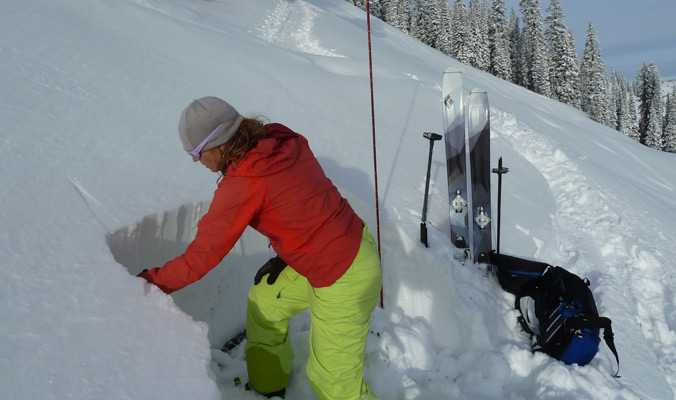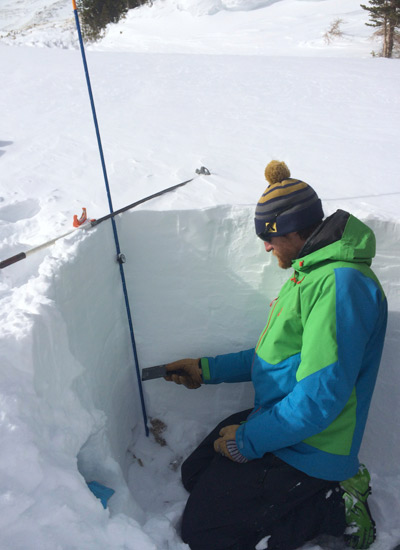Analyzing snowpack starts before you leave for a tour and only ends when you’re safely back home. After reading the morning’s forecast, digging a snow pit in the field can better enhance your understanding of they day’s snow stability. But without a process for gathering and implementing upon the information pits present, digging and analyzing a pit’s layers can be tedious. Here are a few tips to streamline the process, so you can gather information in a timely and informative manner.

Sarah Carpenter gets ready to do a stability test. [Photo] Don Carpenter
Do Your Research
It’s important to check the avalanche hazard forecast before heading out to see what forecasters have to say about avalanche hazards, stability and the snowpack. Informal and formal stability tests in the field provide opportunities to challenge or support your hypothesis of what stability will be like. Don’t wait until you dig a pit to begin forming an idea of what the snowpack will look like.
If you have a specific question you’re trying to answer, your pits tend to be more focused. Common questions include: is the surface hoar that was buried last week still reactive? How much snow fell on yesterday’s suncrust?
Know where your gear is. Put your snow-study tools in the same place every time you go out. That way, there’s no shuffling to the bottom of your pack to find your snow saw or your ECT cord (knotted P-cord to easily isolate the column). If you have a separate rescue pocket, use it—and only use it for rescue gear.

A snowpack assessment in Grand Teton National Park. [Photo] Sarah Carpenter
Implement Your Knowledge
Snow pits can be daunting. No one wants to stand around, getting cold toes, “wasting time,” while other people are skiing powder. The secret to using snow pits effectively is to dig them efficiently.
Use your probe to find a shallow-to-average (but not ridiculously shallow) depth area on the slope. There’s nothing worse than trying to evaluate stability in a thick, stiff wind pillow. When you’re digging a pit, you’re looking for worst-case scenario indicators. Ask questions like, “What happens if I hit the weak zone?” The probe can also help ensure that you don’t have a tree or boulder in the middle of your pit.
Dig the hole like you’re rescuing someone. Digging a pit is a great time to practice strategic shoveling. Get your partners involved and “rescue the pit.”
Have a system for digging a pit. I dig my pits the same way every time. Before I had my system dialed, I wrote out the step-by-step snow pit guide in my field book until I had it memorized.
My process? First I probe to find an area of shallow-to-average depth. Then I measure the slope angle and check the aspect and elevation. Only after that do I stick my shovel in the snow.
Use a cord to isolate columns. Two meters of P-cord with knots tied in it is a cheap snow study tool, and it’s very effective for isolating columns. Place probes in the snow at the correct width for an isolated column and use the cord as a saw to isolate columns, instead of carrying around a snowsaw. It’s lightweight and fast, but know when it won’t hold up, like when dealing with buried crusts.
If you don’t have a system, watch someone who does. Take notes while your avalanche course instructor demos a pit. Check out instructional videos for a system that might work for you.

An example of a full profile in Breckenridge, CO. [Photo] Sarah Carpenter
Practice Makes Perfect
Practice your system. Do you remember the first time you practiced with your transceiver? You likely weren’t very fast. We practice rescue skills to improve our efficiency. Do the same for snow pits. Practice, practice, practice.
Don’t be afraid to put your shovel in the snow. Sometimes, it can give you the answer in a go vs. no-go situation. The more efficient you are with your pit-digging system, the more pits you can dig. More pits equal more information and, thus, a more complete picture of the current snowpack. As my friend Ian McCammon says, “Just like you don’t get married after the first date, don’t bet your life on one pit.”
Bottom Line: The process of gathering data in the backcountry is ongoing, and digging snow pits and performing stability tests are just one piece of the decision-making puzzle. And by introducing a methodology to the pit-digging madness, that puzzle can be made even clearer.
—
Sarah Carpenter is the co-owner of the American Avalanche Institute and an AMGA-certified ski guide. Her first job out of college was ski patrolling at Bridger Bowl, Mont., and she’s been working in the snow and avalanche industry ever since as a patroller, ski guide and avalanche educator.










Related posts: